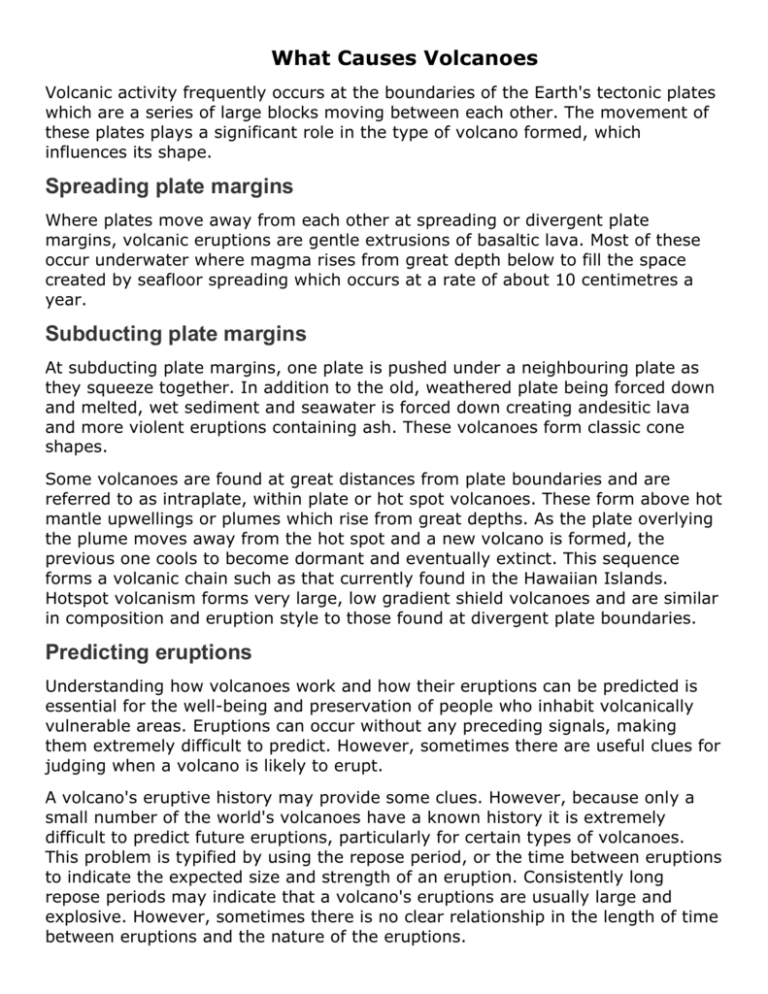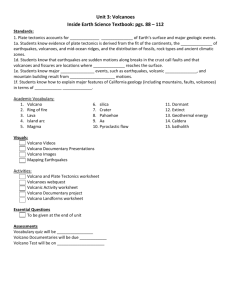What Causes Volcanoes (1) - geography-bbs
advertisement

What Causes Volcanoes Volcanic activity frequently occurs at the boundaries of the Earth's tectonic plates which are a series of large blocks moving between each other. The movement of these plates plays a significant role in the type of volcano formed, which influences its shape. Spreading plate margins Where plates move away from each other at spreading or divergent plate margins, volcanic eruptions are gentle extrusions of basaltic lava. Most of these occur underwater where magma rises from great depth below to fill the space created by seafloor spreading which occurs at a rate of about 10 centimetres a year. Subducting plate margins At subducting plate margins, one plate is pushed under a neighbouring plate as they squeeze together. In addition to the old, weathered plate being forced down and melted, wet sediment and seawater is forced down creating andesitic lava and more violent eruptions containing ash. These volcanoes form classic cone shapes. Some volcanoes are found at great distances from plate boundaries and are referred to as intraplate, within plate or hot spot volcanoes. These form above hot mantle upwellings or plumes which rise from great depths. As the plate overlying the plume moves away from the hot spot and a new volcano is formed, the previous one cools to become dormant and eventually extinct. This sequence forms a volcanic chain such as that currently found in the Hawaiian Islands. Hotspot volcanism forms very large, low gradient shield volcanoes and are similar in composition and eruption style to those found at divergent plate boundaries. Predicting eruptions Understanding how volcanoes work and how their eruptions can be predicted is essential for the well-being and preservation of people who inhabit volcanically vulnerable areas. Eruptions can occur without any preceding signals, making them extremely difficult to predict. However, sometimes there are useful clues for judging when a volcano is likely to erupt. A volcano's eruptive history may provide some clues. However, because only a small number of the world's volcanoes have a known history it is extremely difficult to predict future eruptions, particularly for certain types of volcanoes. This problem is typified by using the repose period, or the time between eruptions to indicate the expected size and strength of an eruption. Consistently long repose periods may indicate that a volcano's eruptions are usually large and explosive. However, sometimes there is no clear relationship in the length of time between eruptions and the nature of the eruptions. Earthquake activity around a volcano can provide valuable information. An eruption can be preceded by hundreds of small earthquakes know as earthquake swarms. Earthquakes also can indicate that magma is moving beneath a volcano. However, eruptions can occur with no perceivable change in seismic activity. Small changes in the shape of a volcano such as bulging may indicate that magma is rising. Accurately measuring the summit and slopes of a volcano is one of the most important tools used for forecasting an eruption. Temperature changes in surface lakes or the groundwater near a volcano also can be a valuable early detection tool, although not all large changes in temperature are related to volcanic eruptions. Gases emitted at, or near a volcano may show that a magma chamber is refilling or that a new composition of magma is rising from depth. Changes in the volume or type of volcanic gases produced also may be an indicator of magma activity. Interesting fact: The interior of many volcanoes stay hot for a long time. This heat can warm underground water in the vicinity of the volcano. The heated water then reaches the surface to form geysers, fumaroles, bubbling mud pools and hot springs as well as create occurrences of sulphur and other mineral deposits.








